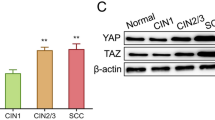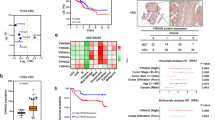Abstract
Slug is a transcription factor and E-cadherin repressor, which has recently been demonstrated to be important for cancer cells to down-regulate epithelial markers and up-regulate mesenchymal markers in order to become motile and invasive. In the present study, we assessed the relevance of Slug for invasion and growth potential of esophageal adenocarcinoma (EA) cells in vitro and in vivo. Slug expression was detected in nine human esophageal cancer cell lines. OE33 cell line was infected with Slug siRNA to knockdown of Slug; TE7 cell line was infected with full Slug cDNA to increase Slug expression. Then, Bcl-2 and E-cadherin expression and Caspase-3 activity were analyzed. MTT assay was applied to detect growth curve. The flow cytometric and Hoechst33258 staining was performed to detect apoptosis. The cells invasion in vitro was detected with a Boyden chamber. A pseudometastatic model of OE33 and TE7 in immunodeficient mice was used to assess the effects of knockdown of Slug and Slug overexpression on metastasis development. A subcutaneously nude mice xenograft model of OE33 and TE7 was used to assess the effects of knockdown of Slug and Slug overexpression on tumor growth. Immunohistochemical staining was used to analyze the expression of Slug, bcl-2 and E-cadherin, and TUNEL was used to detected apoptosis in vivo. Western blotting and RT-PCR showed that Slug expression was detectable in 7 of 9 human esophageal cancer cell lines. Bcl-2 was down-regulated and E-cadherin was up-regulated significantly in Slug siRNA-infected OE33 cell line (P < 0.01). Bcl-2 was upregulated and E-cadherin was downregulated significantly in Slug cDNA-infected TE7 cells (P < 0.05). OE33 cells with Slug knockdown were shown to possess markedly decreased invasiveness (P < 0.05) and markedly increased apoptosis (P < 0.05). Slug cDNA-infected TE7 cells were shown only to possess markedly increased invasiveness (P < 0.05). There was significant relationship between Slug knockdown or Slug overexpression and cells proliferation (respectively, P < 0.05). Animals injected with Slug-silenced OE33 cells had fewer seeded tumor (P < 0.01), more apoptosis cells (P < 0.05) and significantly xenograft tumor growth regression (P < 0.05). But in Slug cDNA-infected TE7 cells, more seeded tumor number and significantly xenograft tumor growth were found in xenograft tumor (respectively, P < 0.05). It was showed in the subcutaneously nude mice xenograft model tumor tissue, bcl-2 expression was reduced followed by the decrease of Slug expression in Slug-silenced tumor, and bcl-2 expression was increased followed by the increase of Slug expression. In pseudometastatic model, E-cadherin overexpression was found in Slug siRNA tumor tissue, but less E-cadherin expression was found in Slug cDNA tissue. Slug is an important modulator of apoptosis, growth and invasion in EA in vitro and in vivo. Slug inhibition may represent a novel strategy for treatment of EA.







Similar content being viewed by others
References
Liotta LA. An attractive force in metastasis. Nature. 2001;410:24–5.
Steeg PS. Tumor metastasis: mechanistic insights and clinical challenges. Nat Med. 2006;12:895–904.
Thiery JP, Sleeman JP. Complex networks orchestrate epithelial-mesenchymal transitions. Nat Rev Mol Cell Biol. 2006;7:131–42.
Peinado H, Olmeda D, Snail CA. Zeb and bHLH factors in tumour progression: an alliance against the epithelial phenotype? Nat Rev Cancer. 2007;7:415–28.
Deryugina EI, Quigley JP. Matrix metalloproteinases and tumor metastasis. Cancer Metastasis Rev. 2006;25:9–34.
Castro Alves C, Rosivatz E, Schott C, Hollweck R, Becker I, Sarbia M, Carneir F, Beckerl K-F. Slug is overexpressed in gastric carcinomas and may act synergistically with SIP1 and Snail in the down-regulation of E-cadherin. J Pathol. 2007;211:507–15.
Alves CC, Carneiro F, Hoefler H, Becker KF. Role of the epithelial-mesenchymal transition regulator Slug in primary human cancers. Front Biosci. 2009;14:3035–50.
Martin TA, Goyal A, Watkins G, Jiang WG. Expression of the transcription factors snail, slug, and twist and their clinical significance in human breast cancer. Ann Surg Oncol. 2005;12:488–96.
Jethwa P, Naqvi M, Hardy RG, Hotchin NA, Roberts S, Spychal R, Tselepis C. Overexpression of Slug is associated with malignant progression of esophageal adenocarcinoma. World J Gastroenterol. 2008;14:1044–52.
Shioiri M, Shida T, Koda K. Slug expression is an independent prognostic parameter for poor survival in colorectal carcinoma patients. Br J Cancer. 2006;94:1816.
Uchikado Y, Natsugoe S, Okumura H, Setoyama T, Matsumoto M, Ishigami S, Aikou T. Slug expression in the E-cadherin preserved tumors is related to prognosis in patients with esophageal squamous cell carcinoma. Clin Cancer Res. 2005;11:1174–80.
Bermejo-Rodriguez C, Perez-Caro M, Perez-Mancera PA, Sanchez-Beato M, Piris MA, Sanchez-Garcia I. Mouse cDNA microarray analysis uncovers Slug targets in mouse embryonic fibroblasts. Genomics. 2006;87:113–8.
Kim MR, Lee JY, Park MT, Chun YJ, Jang YJ, Kang CM, Kim HS, Cho CK, Lee YS, Jeong HY, Lee SJ. Ionizing radiation can overcome resistance to TRAIL in TRAIL-resistant cancer cells. FEBS Lett. 2001;505:179–84.
Victoria B, Hector P, Mirna AP-M, Fraga MF, Manel E, Amparo C. The transcription factor Slug expression and induces epithelial to mesenchymal transitions: a comparison with Snail and E47 repressors. J Cell Sci. 2003;116:499–511.
Thiery JP, Chopin D. Epithelial cell plasticity in development and tumor progression. Cancer Metastasis Rev. 1999;18:31–42.
Zhang KJ, Zhang BY, Zhang KP, Tang LM, Liu SS, Zhu DM, Zhang DL. Clinicopathologic significance of slug expression in human intrahepatic cholangiocarcinoma. World J Gastroenterol. 2010;16:2554–7.
Hemavathy K, Ashraf SI, Ip YT. Snail/slug family of repressors: slowly going into the fast lane of development and cancer. Gene. 2000;257:1–12.
Inukai T, Inoue A, Kurosawa H, et al. SLUG, a ces-1-related zinc finger transcription factor gene with antiapoptotic activity, is a downstream target of the E2A-HLF oncoprotein. Mol Cell. 1999;4:343–52.
Cano A, Perez-Moreno MA, Rodrigo I, et al. The transcription factor snail controls epithelial-mesenchymal transitions by repressing E-cadherin expression. Nat Cell Biol. 2000;2:76–83.
Guaita S, Puig I, Franci C, et al. Snail induction of epithelial to mesenchymal transition in tumor cells is accompanied by MUC1 repression and ZEB1 expression. J Biol Chem. 2002;277:39209–16.
Acknowledgments
We take this opportunity to specifically thank the reviewers and editors for their kind instructions that may be helpful for our further studies.
Conflict of interest
The authors promised there were not any possible conflicts of interest in this research.
Author information
Authors and Affiliations
Corresponding author
Additional information
Kejun Zhang, Shaoyan Zhang, Xuelong Jiao contributed equally to this work.
Rights and permissions
About this article
Cite this article
Zhang, K., Zhang, S., Jiao, X. et al. Slug regulates proliferation and invasiveness of esophageal adenocarcinoma cells in vitro and in vivo. Med Oncol 28, 1089–1100 (2011). https://doi.org/10.1007/s12032-010-9652-7
Received:
Accepted:
Published:
Issue Date:
DOI: https://doi.org/10.1007/s12032-010-9652-7




